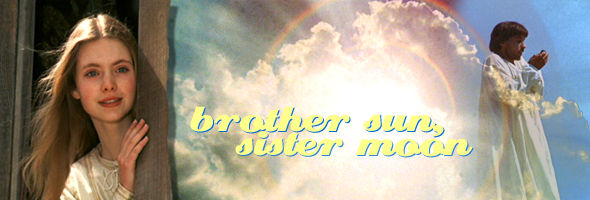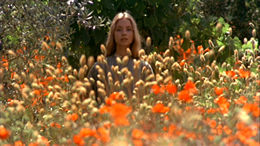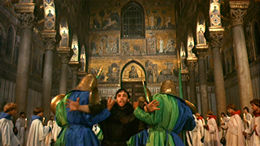
Color, 1972, 121m. / Directed by Franco Zeffirelli / Starring Graham Faulkner, Jodi Bowker / Paramount (US R1 NTSC) / WS (1.78:1) (16:9), Versatil (Brazil R4 NTSC)
The impressionistic story follows the first half of the life of Francesco (Graham Faulkner), whose father is a successful Assisian merchant. After a war campaign, the good-natured Francesco falls ill and experiences a religious vision involving crosses and the necessity to reject worldly goods. Awakened to the joy of the world around him, Francesco finds a kindred spirit in the form of Clare (Clash of the Titans' Judi Bowker), destined to become a saint herself. The socially prominent crusader manages to amass a group of followers and enrages his father, who finds the wasteful giving away of money disgraceful. Francesco responds by rejecting everything, including his inheritance and the clothes from his back, in order to start a new religious order. Unfortunately the church is less than pleased as well, leading Francesco and his devotees to a long journey leading to a climactic audience with Pope Innocent II (Alec Guinness).
The big stumbling block for most viewers of Brother Sun, Sister Moon is the score, featuring "words and music" by twee favorite Donovan. Since the pop minstrel was starring (and singing) in Jacques Demy's The Pied Piper for Paramount at the same time, the studio thought it would help the film appeal to the youth crowd by plastering innocuous ditties about pretty flowers and sunshine throughout Zeffirelli's film as well. Never mind that the director had already recruited Riz Ortolani
Paramount's DVD of the standard English language version of Brother Sun, Sister Moon looks beautiful all around, a huge improvement over the pale, cropped transfers plaguing viewers for years. Colors are vivid throughout, and detail looks crisp enough to reveal some additional grain during a few scenes shot with zoom lenses. The 1.78:1 framing looks fine, though the end credits are presented at 1.66:1 with black bars on the sides of the screen. The Donovanphonic mono audio sounds robust, especially when spread out through front speakers. As usual with Paramount, there are no extras - not even a trailer.
Fans interested in the film's original incarnation may want to check out the pricier Brazilian DVD under the title Irmão Sol, Irmã Lua, which contains the Italian version but without any English-language options. It's also a full frame transfer and doesn't look remotely as attractive, but the disc does contain the Ortolani music and, significantly, runs 135 minutes. The difference isn't as drastic as one might imagine; the international cut was simply fine-tuned by trimming some fat off a few transitional scenes and shortening shots here and there, tightening the pace without sacrificing content.
After turning on a whole anti-war generation to the words of Shakespeare with his 1968 Romeo and Juliet for Paramount, Franco Zeffirelli spent the next four years dabbling in opera productions and mounting another lyrical period piece for the same studio, this time based on the life of
 Francesco Bernardone, known to the world as St. Francis of Assi. Though geared once again for the flower power crowd (to such an extent that Paramount's DVD even calls it the story of "society's first dropout"), Brother Sun, Sister Moon was less successful but earned a fervent cult following over the years.
Francesco Bernardone, known to the world as St. Francis of Assi. Though geared once again for the flower power crowd (to such an extent that Paramount's DVD even calls it the story of "society's first dropout"), Brother Sun, Sister Moon was less successful but earned a fervent cult following over the years.
 One of the most visually sumptuous films of its era, Brother Sun, Sister Moon sports incredible cinematography by Ennio Guarnieri, fresh off Camille 2000 and The Garden of the Finzi-Continis (how's that for contrast?), and Zeffirelli's usual sharp eye for period detail. Filmed in the locations inhabited by the real St. Francis, the film looks authentic and showcases real Byzantine Christian artwork to striking effect. In keeping with Zeffirelli's penchant for aesthetically pleasing, bland young leads (which would lead him to disaster with Endless Love), Faulkner and Bowker do well enough, with the former rising up to some effective moments in the second half of the film. (And oncea again, Zeffirelli snuck some controversial nudity into his PG-rated film that had schoolteachers and church groups scrambling for their VCR remotes.) Cult movie fans should also keep an eye out for the great Adolfo Celi (Diabolik, Thunderball), dubbed as usual, as a greedy member of the church consulate. Strangest of all, the script was co-written by incendiary "non-feminist" director Lina Wertmüller, though you'd have to dig long and hard to find any trace of her persona here.
One of the most visually sumptuous films of its era, Brother Sun, Sister Moon sports incredible cinematography by Ennio Guarnieri, fresh off Camille 2000 and The Garden of the Finzi-Continis (how's that for contrast?), and Zeffirelli's usual sharp eye for period detail. Filmed in the locations inhabited by the real St. Francis, the film looks authentic and showcases real Byzantine Christian artwork to striking effect. In keeping with Zeffirelli's penchant for aesthetically pleasing, bland young leads (which would lead him to disaster with Endless Love), Faulkner and Bowker do well enough, with the former rising up to some effective moments in the second half of the film. (And oncea again, Zeffirelli snuck some controversial nudity into his PG-rated film that had schoolteachers and church groups scrambling for their VCR remotes.) Cult movie fans should also keep an eye out for the great Adolfo Celi (Diabolik, Thunderball), dubbed as usual, as a greedy member of the church consulate. Strangest of all, the script was co-written by incendiary "non-feminist" director Lina Wertmüller, though you'd have to dig long and hard to find any trace of her persona here.
 (whose "More" theme from Mondo Cane was still popular at the time) for composing duties; in the end, Italian audiences got the lush Ortolani music, while everyone else was stuck with Donovan. Donovan's songs were "arranged" with orchestral passages by Ken Thorne, who later performed musical surgery on Superman II. Ironically, Ortolani's score has remained in print on Italian vinyl and CD for decades, while Donovan's work never merited a soundtrack release in any format at all.
(whose "More" theme from Mondo Cane was still popular at the time) for composing duties; in the end, Italian audiences got the lush Ortolani music, while everyone else was stuck with Donovan. Donovan's songs were "arranged" with orchestral passages by Ken Thorne, who later performed musical surgery on Superman II. Ironically, Ortolani's score has remained in print on Italian vinyl and CD for decades, while Donovan's work never merited a soundtrack release in any format at all.
